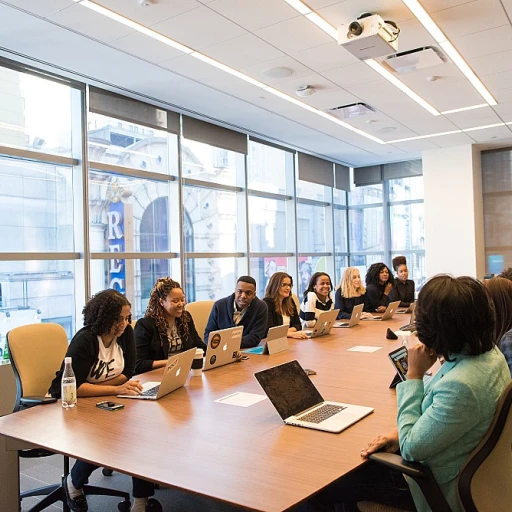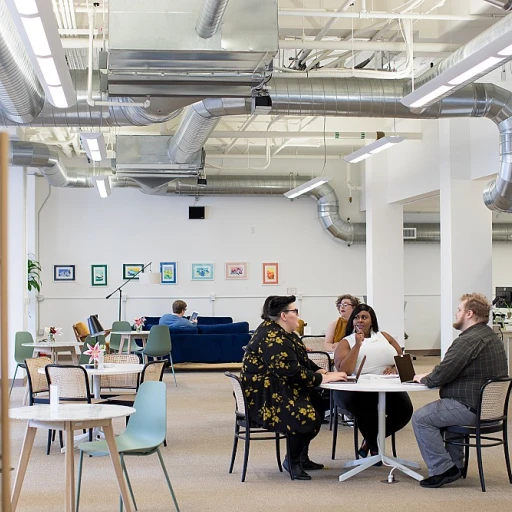
Cultivating a Mindful Workspace: Setting the Tone for Success
Creating a Health-Conscious Office Environment
In today's fast-paced corporate world, the significance of a health-conscious office environment in New Zealand cannot be overstated. Office managers are the custodians of culture, and by weaving mindfulness into the fabric of their workspace, they set the tone for a culture of success. A mindful workspace operates on the principle of presence, which means encouraging employees to focus on the present task with full attention and intention. Research shows that mindfulness practices lead to lower stress levels, enhanced concentration, and a boost in general well-being among employees (NZ Journal of Human Resource Management, 2021).
Implementing Mindful Decor and Design
As an office management analyst in New Zealand, it's important to pay attention to the physical space that surrounds your team. Introducing natural elements, such as plants or calming colors, can significantly reduce workplace anxiety and enhance productivity. Studies from the Wellington School of Design suggest that mindful decor not only improves aesthetic appeal but can increase employee focus and creativity by up to 15%. By integrating ergonomic furniture and creating open spaces that promote collaboration, office managers can develop an environment conducive to both personal welfare and professional excellence.
Integrating Mindfulness into Daily Routines
Embedding mindfulness into the daily office routine is another instrumental strategy. This can be through starting meetings with a short guided meditation or encouraging regular mindfulness breaks amongst staff. Such initiatives honor the human side of the workforce and show that the company values mental health as much as productivity. These practices can cultivate an atmosphere where employees feel more connected to their work and team, fostering a sense of community and cooperation, which is indispensable in the modern collaborative office setting.
Empowering with Mindful Communication
Effective communication is the cornerstone of any successful organization. A mindful approach to communication involves active listening, thoughtful responses, and an open-minded attitude—all of which are crucial for an office manager overseeing team dynamics. Emphasizing empathic communication can remedy misunderstandings and facilitate stronger relationships among staff. This attentive manner of interaction not only alleviates tension but also creates a platform for innovative ideas and joint problem-solving, crucial in navigating the complexities of today's marketplace.
The Path to Peak Productivity: Mindfulness Techniques for Office Managers
Integrating Mindfulness into Daily Office Management
Mindfulness isn't just a personal wellness trend; it’s an approach that can transform office management in New Zealand businesses. By adopting mindfulness techniques, office managers can promote peak productivity while nurturing a supportive work environment. Let's look at practices such as starting meetings with a short meditation, encouraging regular breaks, and setting a mindful tone that can lead to more focused and efficient workflows.
Statistics show that workplaces embracing mindfulness report a significant decrease in stress levels, leading to a more dynamic and harmonious office culture. A study published in the journal Psychological Science found that even brief meditation practice improved cognitive skills and the ability to maintain attention.
The Power of Purposeful Pauses
The office manager orchestrating mindful breaks throughout the day can see improvements in employee focus and satisfaction. Techniques such as deep breathing exercises or short walks can rejuvenate staff and foster a more productive workday. By creating opportune moments for employees to regroup mentally, office managers can make strides toward bettering the workplace's overall well-being.
Quotes from leading mindfulness practitioners underscore the importance of finding balance in the busy day-to-day operations of a workspace. As Thich Nhat Hanh eloquently states, 'The most precious gift we can offer others is our presence. When mindfulness embraces those we love, they will bloom like flowers.'
Embracing Mindful Communication for Better Collaboration
Effective communication is at the heart of any flourishing business. Office managers can leverage mindfulness to create a culture of clear and thoughtful communication. This involves active listening, being fully present in interactions, and responding rather than reacting. Mindful communication boosts collaboration and innovation, transforming ordinary interactions into opportunities for growth and connection.
By implementing strategies such as mindful listening and conscious email practices, managers are not only improving efficiency but also ensuring that the team is working in harmony towards common objectives. Examples include reducing the number of unnecessary meetings and emails, which can clutter an employee's day and hinder productivity.
Implementing Tech with Mindfulness at Forefront
In the digital age, office managers in New Zealand must also be mindful of how technology affects workplace productivity and engagement. Introducing apps that promote organized task management and allowing for focused work periods, such as the Pomodoro Technique, can significantly benefit workflow and time management.
However, balance is key. Encouraging employees to take tech-free breaks and setting boundaries on after-hours work communications are important steps in cultivating a mindful office space. Such strategies can prevent burnout and ensure that technology remains a facilitator of productivity, not a disruptor.
Feedback Loops and Mindful Reflection
Finally, the mindful office manager must establish feedback loops that encourage reflection and continuous improvement. Scheduling regular one-on-one meetings where employees can discuss challenges and success stories can lead to a more engaged and resilient team.
Focusing on KPIs related to employee well-being and satisfaction, such as staff turnover rates and office morale levels, can provide insight into the efficacy of mindfulness practices in the office. Suite of metrics that align with the company's values and goals ensures that the benefits of mindfulness are both quantifiable and aligned with the overall mission of the organization.
Flexible Scheduling: The Balanced Approach to Work and Lifestyle
Embracing Work-Life Harmony with Flexible Scheduling
The modern workplace is rapidly evolving, with a notable trend towards flexible working arrangements. For savvy office managers, this shift is not just about accommodating the millennial workforce; it's about fostering an environment that promotes well-being and, as a consequence, productivity. By implementing flexible schedules, office managers can create a work culture that respects the individual needs and preferences of each team member, leading to a healthier and more engaged workforce.
Recent statistics indicate that flexible work options can lead to a reduction in stress and an increase in job satisfaction. In New Zealand, a study showed that 63% of employees report higher productivity levels when working flexibly. This highlights the importance of adapting to the evolving needs of the workforce, and the potential benefits such a strategy can bring to business outcomes.
Strategies for Successful Flexible Scheduling
- Assess individual and team needs - Understand the requirements and preferences of your team members to find a balance that aligns with company goals.
- Create clear policies - Develop guidelines that outline eligibility, the process for requesting flexible hours, and expectations for accountability.
- Utilize technology - Invest in robust systems for remote communication and project management to ensure productivity is maintained, no matter where your team is working.
- Prioritize communication - Keep open lines of dialogue to address any concerns or adjustments needed as you transition to more flexible work arrangements.
By integrating these strategies, you can cultivate a mindfulness culture within your workspace, where employees feel respected and valued—a key component of the mindful office management practices we've explored.
Impact of Flexibility on Office Dynamics
When you introduce flexible scheduling, you might notice a ripple effect across the office dynamics. Employees who have control over their work schedules often exhibit higher levels of engagement and loyalty. As a result, there's likely to be a palpable boost in morale and a decrease in absenteeism, which directly contribute to a sustainable and productive work environment.
Moreover, these practices support the overarching theme of mindfulness in the workplace, encouraging employees to work smarter, not harder. By acknowledging and catering to the diverse lifestyles and responsibilities outside of work, office managers can demonstrate empathy and understanding, which are crucial for maintaining a motivated and mindful office.
"To win in the marketplace you must first win in the workplace." – Doug Conant, former CEO of Campbell Soup Company. This quote encapsulates the essence of providing your team with the tools and flexibility they need to thrive, enhancing both individual and organizational success.
The Ripple Effect of Employee Engagement on Office Dynamics
Understanding the Impact of Engaged Employees
In the heart of every thriving New Zealand office lies a shared characteristic - a high level of employee engagement. But what does this really mean for an office manager seeking to enhance workplace well-being and productivity? Engaged employees display a profound connection to their work, they're enthusiastic and committed. In essence, they care more, do more, and stay longer. This is not mere conjecture; numerous studies, including those from Gallup, show that companies with highly engaged workforces outperform their peers by 147% in earnings per share.
But how can mindfulness help? By integrating mindfulness practices within the office environment, which we have already explored, managers can create an atmosphere where employees feel valued and focused. When employees are grounded in the moment, they're more likely to listen actively, participate in discussions, and contribute innovative ideas, fostering a collaborative and dynamic office culture.
Fostering Team Collaboration through Engagement
Teamwork is the backbone of any successful business, so when we talk about employee engagement, we are also referring to their willingness to work together toward common goals. A simple way to observe this dynamic is to see how individuals bring their unique strengths to the table, feed off each other's energy, and collectively drive the company's objectives forward. As office managers, encouraging regular team-building activities and acknowledging both individual and team accomplishments are pivotal actions. It not only fuels a sense of unity but also empowers employees to take ownership of their roles within the company.
Boosting Morale and Reducing Turnover with Mindful Management
One cannot downplay the role of morale in reducing staff turnover – a significant cost saver for any business. Engaged employees typically exhibit higher morale and satisfaction in their roles. Mindful management techniques, such as giving constructive feedback, offering support and resources for personal development, and maintaining transparency in communication, are powerful tools to keep morale high. These approaches make employees feel respected and understood, which substantially reduces the likelihood of staff turnover. In today's competitive job market, particularly in New Zealand's growing industries, retaining top talent is a clear indicator of a successful and mindful office manager.
Key Performance Indicators for Employee Engagement
In the realm of office management, success must be quantifiable. Therefore, Key Performance Indicators (KPIs) for measuring employee engagement are crucial. These can include metrics such as employee retention rates, employee satisfaction survey scores, productivity levels, and the quality of work produced. By regularly reviewing these KPIs, office managers can gain valuable insights into the correlation between mindful management practices and overall workplace effectiveness. Adjusting strategies in response to these metrics can lead to continuous improvement in employee engagement and, consequently, a thriving office environment.
Measuring Success: KPIs for a Mindful Office Manager
Navigating KPIs for Enhanced Office Management
In the pursuit of mindful office management, one cannot overlook the importance of effectively measuring success. Key Performance Indicators (KPIs) serve as quantifiable measures that office managers can use to gauge the productivity and well-being of their workspace. The right KPIs provide a clear lens to view the impact of initiatives such as cultivating a mindful workspace and implementing mindfulness techniques. In this segment, we'll delve into how office managers can utilize KPIs to foster a thriving and balanced office environment.
Aligning KPIs with Mindful Management Objectives
To truly capture the essence of a mindful office, KPIs should be aligned with the goals of creating an environment that promotes both well-being and efficiency. Metrics such as employee satisfaction scores, retention rates, and absenteeism offer insights into the success of creating a supportive work culture. Meanwhile, tracking project completion rates and time management can shed light on productivity improvements resulting from introduced mindfulness practices and flexible scheduling.
The Interplay Between Well-being and Productivity Metrics
It is fundamental for office managers to appreciate the symbiotic relationship between employee well-being and productivity. Statistics show that happy employees are up to 20% more productive than unhappy ones. When employees are engaged, as discussed in the ripple effect on office dynamics, their performance and job satisfaction often increase correspondingly. KPIs that measure these aspects might include employee net promoter scores (eNPS), which reflect the likelihood of employees to recommend the workplace to their peers as a good place to work.
Utilizing Feedback Loops for Continuous Improvement
Constructive use of KPIs involves creating feedback loops. This means not just tracking statistics but also acting upon them. Surveys and suggestion boxes can be tools that contribute to these loops, providing real-time data that's invaluable for continuous improvement. For instance, implementing regular wellness surveys can fuel strategies for enhancing well-being, and correlating this data with productivity stats can guide office managers in iterating on schedules and mindfulness techniques. This approach ensures that the office manager's strategic guidance is data-driven and responsive to the evolving needs of the team.
Technological Tools to Aid KPI Tracking
In today’s digital era, harnessing technology can streamline the collection and analysis of KPIs. Software platforms that integrate analytics provide an efficient means for monitoring KPIs, offering the office manager a dashboard view of where attention is needed. These tools can help to quickly identify trends and areas for action, ideally leading to rapid and informed decision-making. Subsequently, office managers can share these insights with their teams, promoting transparency and collective responsibility for the office’s well-being and productivity.
KPIs as a Reflection of Cultivating a Mindful Workspace
Ultimately, KPIs for a mindful office manager are reflective of the holistic approach to workspace management. By keeping a pulse on metrics that encapsulate mental wellness and work output, office managers can curate a workplace that not only meets business objectives but also enriches the lives of its employees. As the touchstone of office management strategy, KPIs empower managers to lead with empathy, accuracy, and an eye towards the sustainable growth of both individuals and the company.







